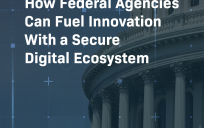This blog post is an excerpt from a sponsor of our latest IT modernization guide.
Government agencies have big responsibilities, including serving the public and ensuring their cybersecurity posture is strong. But outdated technology systems compounded with the challenge of a dwindling workforce make these missions all the more difficult to achieve.
Moving more of government’s mission-critical operations to the cloud can help mitigate cyber risk and improve employee productivity to overcome these challenges. Such mission-critical operations include human resources management, finance and accounting, as well as supply chain and enterprise asset management.
In an interview with GovLoop, Wayne Bobby, Vice President for Federal Government at Infor, shared how government can successfully move such operations to the cloud. Infor is a software solutions company that prioritizes helping government agencies build their solutions from the ground up to simplify the overall business of managing government.
“Government initially began moving the more basic things, like email, to the cloud,” Bobby said. “Now, cloud is becoming more fundamental to how government agencies get their work done.”
Agencies are now moving more mission-critical solutions that concern cybersecurity, workforce management and finance to cloud. However, Bobby said, some agencies may be reticent to do so over security concerns. Cloud, however, can actually improve cybersecurity through programs like the Federal Risk and Authorization Management Program (FedRAMP), which provides standardized approaches to security.
“With FedRAMP requirements, the data reflects better security from the infrastructure to the platform and application layers of the business. These security features have improved interaction between vendors and agencies to better support the program mission.”
FedRAMP, helps agencies by defining standards for security, as well as policy guidelines for vendors. “They’ve created a lot of discipline that was greatly needed,” Bobby added.
Working with a FedRAMP-approved vendor, agencies can use more streamlined services. Rather than purchasing a different product or monitoring tool for every mission need, agencies can use service-level agreements and a standardized set of fewer technology tools. Because service-level agreements are spelled out contracts between providers and agencies, government can have more control over their cloud services, including quality, availability and responsibilities.
“Organizations have decided to use cloud service-level agreements to address the entire program need as opposed to thousands of different tools,” Bobby said. “This creates an environment with fewer variables and allows for more 24/7 monitoring and uptime and better disaster recovery. There’s much more stability there.”
Cloud is also helping government leverage new capabilities that were more difficult before. “Historically, Government provided solutions through more of a transactional-based nature,” he said. “But as the next generation moves to cloud software, demands are becoming more informational and less transactional.”
Informational services allow agencies to be better prepared to make decisions based on fact.
For example, an agency like the Department of Veterans Affairs could keep track of patients making appointments or coming to the emergency room and define how many clinicians need to be on staff. Or the Defense Department can keep track of major assets like ships, submarines, aircraft and other requirements to support the war fighter and schedule maintenance accordingly.
“Agencies need more information about their workforce, financials and supply chains,” Bobby said. “With an informational approach to problem solving, agencies can be more proactive rather than reactive with transactional-based services.”
Solution providers like Infor are working to help agencies harness the cloud to achieve IT modernization as well as program success. “All applications that we provide, including HR supply chain management, finance/accounting, procurement and asset management can be delivered on solutions in the cloud,” Bobby said. “And you can buy everything from Infor while getting the speed and quality provided from Amazon Web Services.”
With such services, agencies can have 24/7 access and monitoring of their systems, software upgrades completed without having to disrupt services, and security with standardized and approved solutions.
For cloud, one size fits all cannot effectively meet the mission and requirements of the public sector. The needs of an HR manager are not the same as those of a city manager or a 311 call center. By leveraging cloud supported by a comprehensive service level agreement, informational-based decision support and standardized security requirements, agencies across federal, state and local governments can fill their unique roles and achieve program success.






Leave a Reply
You must be logged in to post a comment.